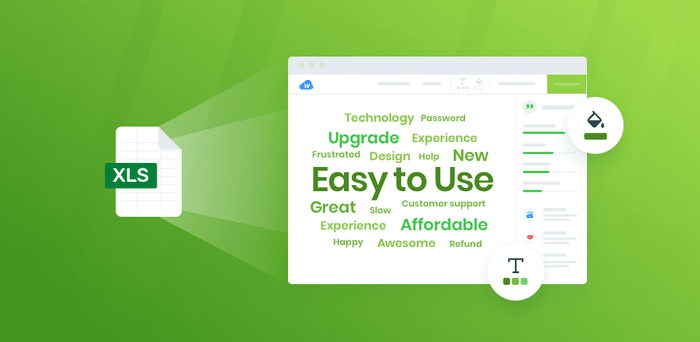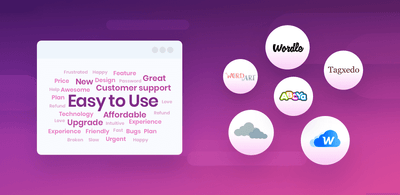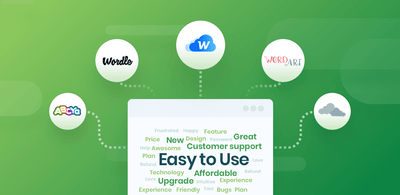The Easiest Way to Create a Word Cloud From Excel Data

A word cloud, or tag cloud, is a visual representation of keywords within a text. To generate a professional word cloud using MonkeyLearn’s word cloud generator, just upload your Excel data and click 'generate word cloud'.

Word clouds are an easy-to-use and extremely helpful tool for businesses that want to find out the most important topics on their customers’ minds. You can analyze thousands of tweets about your brand, evaluate customer surveys, and more, in just a few minutes.
Excel is one of the most used tools for storing and analyzing business data (surveys, social media mentions, customer service data, etc.) MonkeyLearn offers a word cloud tool that you can use to gain insights from your Excel data. Dive right into our word cloud generator; no sign-up required. Or follow the tutorial below:
How to Create A Word Cloud From Excel Data
MonkeyLearn’s AI-powered word cloud tool is super easy to use and employs advanced algorithms that help it deliver more accurate results than other word cloud tools, as well as automatically group word pairs. That’s why you’ll also see phrases appear in clouds you create with MonkeyLearn, providing you with more context than just single keywords.
Our tool also reduces words to their root form, a process known as stemming, and determines which words are most relevant – instead of just measuring frequency.
And you can upload Excel sheets in a snap.
1. Upload your Excel data to the word cloud generator
Go to the word cloud generator, click ‘Upload text file’, and choose your Excel doc.

Alternatively, you can enter paste your unstructured Excel data into the text field.
2. Click ‘Generate word cloud’
Your word cloud will be generated in a matter of seconds.

Our sample data set is from online reviews of Zapier. The words that appear larger are the ones that are used most often. And you can see that phrases have been properly grouped together, like “small business owners” and “automate task.”
The column on the right shows the number of times each word appeared and its relevance to the text as a whole.
3. Customize your word cloud
You can edit the original text, choose a background theme, and change the font color to make your word cloud more striking.

If you want only the very top words and phrases, you can limit the number of words you want to appear in your cloud:

4. Download your data
Click ‘Download’ in the upper right corner to save your word cloud as a high-def SVG or PNG image. Or download a CSV file get a list of words, showing word frequency and relevancy score.
If you want to perform more advanced text analysis with MonkeyLearn, then try out our suite of machine learning tools for free:
You can even connect them directly in Google Sheets (with our text analysis Google add-on) or with popular integrations (Zapier, Zendesk, Front, etc) and our APIs in Python, Ruby, PHP, Node, or Java.
The Takeaway
Making word clouds with Excel is a simple but useful tool to visualize the importance of recurring words and phrases in any number of unstructured forms of text: social media, product reviews, customer and employee surveys, etc.
Creating an Excel word cloud with MonkeyLearn is easy, fun, and you can set it up in just a couple of minutes. You’ll get valuable insights right away. Try it now for free.
Or, check out our list of top word cloud generators.

Rachel Wolff
April 30th, 2020






